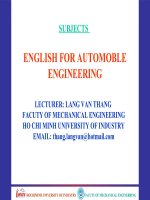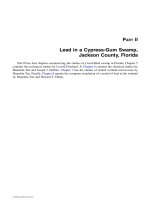Technical english for automotive engineering chapter 5 steering
Bạn đang xem bản rút gọn của tài liệu. Xem và tải ngay bản đầy đủ của tài liệu tại đây (538.82 KB, 7 trang )
STEERING SYSTEM
5
Chapter 5: STEERING SYSTEM.
I. PRE-READING QUESTION
1. How to turn direction of a moving car?
2. What component(s) helps the car change its direction?
3. How about the speed of the front wheels in the car when they turn?
II. READING
1. TURNING THE CAR
You might be surprised to learn that when you turn your car, your front wheels are not
pointing in the same direction. For a car to turn smoothly, each wheel must follow a different
circle. Since the inside wheel is following a circle with a smaller radius, it is actually making
a tighter turn than the outside wheel. If you draw a line perpendicular to each wheel, the lines
will intersect at the center point of the turn. The geometry of the steering linkage makes the
inside wheel turn more than the outside wheel.
Fig 5.1: Turning car with their steering system
2. STEERING TYPES
2.1 Rack-and-pinion Steering
a. System introduction
Rack-and-pinion steering is
quickly becoming the most
common type of steering on cars,
small trucks and SUVs. It is
actually a pretty simple mechanism.
A rack-and-pinion gearset is
enclosed in a metal tube, with each
end of the rack protruding from the
tube. A rod, called a tie rod,
connects to each end of the rack.
Fig 5.2: Rack-and-pinion steering
Technical English for AUTOMOTIVE ENGINEERING.
The pinion gear is attached to
the steering shaft. When you turn
the steering wheel, the gear spins,
moving the rack. The tie rod at each
28
STEERING SYSTEM
5
end of the rack connects to the steering arm on the spindle.
b. Advantages and disadvantages:
+ The advantages:
Fig 5.3: Top view of the rack and pinion steering of
the front-wheel drive Opel (Vauxhall) Astra (up to
1997) and Vectra (up to 1996)
• simple construction
• economical and uncomplicated to
manufacture;
• easy to operate due to good degree
of efficiency;
• contact between steering rack and
pinion is free of play and even
internal damping is maintained
• tie rods can be joined directly to
the steering rack;
• minimal steering elasticity
compliance.
• compact (the reason why this type
of steering is fitted in all European
and Japanese front-wheel drive
vehicles);
• the idler arm (including bearing)
and the intermediate rod are no longer needed;
• easy to limit steering rack travel and therefore the steering angle.
+ The main disadvantages:
• greater sensitivity to impacts;
• greater stress in the case of tie rod angular forces;
• disturbance of the steering wheel is easier to feel (particularly in front-wheel
drivers);
• tie rod length sometimes too short where it is connected at the ends of the rack
• size of the steering angle dependent on steering rack travel;
• decrease in steering ratio over the steer angle associated with heavy steering during parking
if the vehicle does not have power-assisted steering;
• cannot be used on rigid axles.
2.2 Power Rack-and-pinion steering
When the rack-and-pinion is in
a power-steering system, the rack
has a slightly different design. Part
of the rack contains a cylinder with
a piston in the middle. The piston
is connected to the rack. There are
two fluid ports, one on either side
of the piston. Supplying higherpressure fluid to one side of the
piston forces the piston to move,
which in turn moves the rack,
providing the power assist.
Fig 5.4: Power Rack-and-pinion
Technical English for AUTOMOTIVE ENGINEERING.
29
STEERING SYSTEM
5
5.3 Recirculating-ball Steering
Recirculating-ball steering is used
on many trucks and SUVs today. The
linkage that turns the wheels is slightly
different than on a rack-and-pinion
system.
The recirculating-ball steering gear
contains a worm gear. You can image the
gear in two parts. The first part is a block
of metal with a threaded hole in it. This
block has gear teeth cut into the outside of
it, which engage a gear that moves the
pitman arm (Fig 5.5). The steering wheel
connects to a threaded rod, similar to a
bolt, that sticks into the hole in the block.
Fig 5.5: Recirculating-ball steering
When the steering wheel turns, it turns the
bolt. Instead of twisting further into the
block the way a regular bolt would, this bolt is held fixed so that when it spins, it moves the
block, which moves the gear that turns the
wheels.
Instead of the bolt directly engaging
the threads in the block, all of the threads
are filled with ball bearings that recirculate
through the gear as it turns. The balls
actually serve two purposes:
•
reduce friction and wear in the gear.
•
reduce slop in the gear.
Slop would be felt when you change the
direction of the steering wheel without the
balls in the steering gear, the teeth would
come out of contact with each other for a
moment, making the steering wheel feel
loose.
Fig 5.6: Recirculating ball gearbox
Power steering in a recirculating-ball system works similarly to a rack-and-pinion system.
Assist is provided by supplying higher-pressure fluid to one side of the block.
Fig 5.7: The steering damper is supported on the one side at the
intermediate rod and on the other side on the suspension subframe.
Technical English for AUTOMOTIVE ENGINEERING.
30
STEERING SYSTEM
5
5.4 Power Steering
There are a couple of key components in power steering (Fig 5.8) in addition to the rack-andpinion or recirculating-ball mechanism.
Fig 5.8: Power Steering
a. Pump
The hydraulic power for the
steering is provided by a rotaryvane pump (Fig 5.9). This pump is
driven by the car's engine via a belt
and pulley. It contains a set of
retractable vanes that spin inside an
oval chamber.
As the vanes spin, they pull
hydraulic fluid from the return line
at low pressure and force it into the
outlet at high pressure. The amount
of flow provided by the pump
depends on the car's engine speed.
The pump must be designed to
provide adequate flow when the
Fig 5.9: Rotary-vane pump
engine is idling. As a result, the
pump moves much more fluid than necessary when the engine is running at faster speeds.
The pump contains a pressure-relief valve to make sure that the pressure does not get too
high, especially at high engine speeds when so much fluid is being pumped.
b. Rotary Valve
A power-steering system should assist the driver only when he is exerting force on the
steering wheel (such as when starting a turn). When the driver is not exerting force (such as
when driving in a straight line), the system shouldn't provide any assist. The device that
senses the force on the steering wheel is called the rotary valve. (Fig 5.10)
Technical English for AUTOMOTIVE ENGINEERING.
31
STEERING SYSTEM
5
The key to the rotary valve is a
torsion bar. The torsion bar is a thin rod
of metal that twists when torque is
applied to it. The top of the bar is
connected to the steering wheel, and the
bottom of the bar is connected to the
pinion or worm gear (which turns the
wheels), so the amount of torque in the
torsion bar is equal to the amount of
torque the driver is using to turn the
wheels. The more torque the driver uses
to turn the wheels, the more the bar
twists.
The input from the steering shaft
forms the inner part of a spool-valve
assembly. It also connects to the top end
of the torsion bar. The bottom of the torsion bar connects to the outer part of the spool valve.
The torsion bar also turns the output of the steering gear, connecting to either the pinion gear
or the worm gear depending on which type of steering the car has.
Fig 5.10: The rotary valve
As the bar twists, it rotates the inside of the spool valve relative to the outside. Since the
inner part of the spool valve is also connected to the steering shaft (and therefore to the
steering wheel), the amount of rotation between the inner and outer parts of the spool valve
depends on how much torque the driver applies to the steering wheel.
III. NEW WORDS
direction
smoothly
wheel
intersect
geometry
linkage
tie rod
pinion gear
steering shaft
spindle
Recirculating-ball
steering
spin
rotary-vane pump
steering rack
threaded hole
Power Steering
steering arm
Power Rack-andpinion
pitman arm
hydraulic
pulley
Retractable vane
adequate
Rotary Valve
torsion bar
spool-valve
assembly
assist
twist
exerting force
torque
slop
belt
pressure-relief
valve
sense
pinion
inner part
connect
rotate
rack-and-pinion
gearset
steering wheel
angular forces
perpendicular
Rack-and-pinion
steering
worm gear
IV. COMPREHENSION QUESTION
1. When you turn your car, are your front wheels pointing in the same direction?
----------------------------------------------------------------------------------------------------------------2. How to turn your car smoothly?
Technical English for AUTOMOTIVE ENGINEERING.
32
STEERING SYSTEM
5
----------------------------------------------------------------------------------------------------------------3. Why does Rack-and-pinion steering become the most common type of steering on cars?
----------------------------------------------------------------------------------------------------------------4. In Rack-and-pinion steering, what is attached to the steering shaft?
----------------------------------------------------------------------------------------------------------------5. What is/are the main advantages of Rack-and-pinion steering?
----------------------------------------------------------------------------------------------------------------6. What is/are the main disadvantages of Rack-and-pinion steering?
----------------------------------------------------------------------------------------------------------------7. What is/are the difference(s) between Power Rack-and-pinion steering and Rack-andpinion Steering?
----------------------------------------------------------------------------------------------------------------8. Where are the Recirculating-ball steerings applied?
----------------------------------------------------------------------------------------------------------------9. What is/are the difference(s) between Recirculating-ball steering and Rack-and-pinion
Steering?
----------------------------------------------------------------------------------------------------------------10. What is/are components in power steering?
----------------------------------------------------------------------------------------------------------------V. TRUE/FALSE
1. The front wheels in a car are pointing in the same direction. ( True False)
2. For turning smoothly, each wheel must follow a same circle. ( True False)
3. Rack-and-pinion steering is a sophisticated system. ( True False)
4. Rack-and-pinion steering is always applied on trucks. ( True False)
5. Power Rack-and-pinion steering is a power assisted steering system. ( True False)
6. Recirculating-ball steering is used on many trucks and SUVs today. ( True False)
7. The recirculating-ball steering gear contains a worm gear. ( True False)
8. Power steering in a recirculating-ball system works similarly to a rack-and-pinion system.
( True False)
9. Pump and Rotary Valve are key components in power steering. ( True False)
10. The hydraulic power for the steering is provided by a rotary-vane pump. ( True False)
Technical English for AUTOMOTIVE ENGINEERING.
33
STEERING SYSTEM
5
VI. WORD(S) SELECTIONS.
Select ONE word(s) in the below box and fill in the gap in column B with its meaning word in
column A
a. A type of
steering system
uses Pump and
b. To cut into
Rotary Valve
to turn the
front wheels
f. A type of
steering system
uses rack & g. A device to
pinion to turn turn the car
the
front
wheels
d. A rack-andpinion
steering
system assisted by
hydraulic cylinder
with a piston.
e. A type of
steering system is
used on many
trucks and SUVs.
h. A pump
uses vane & i. A type of oil
rotor
to using in steering
control
oil system
flow
j. The device that
senses the force
on the steering
wheel
c. Right angle
No
1
Column A
perpendicular
Column B
No
6
2
Steering wheel
7
3
Power Rack-andpinion steering
8
4
Recirculating-ball
steering
9
5
rotary-vane pump
10
Technical English for AUTOMOTIVE ENGINEERING.
Column A
intersect
Rack-and-pinion
steering
Column B
Power Steering
Rotary Valve
slop
34









